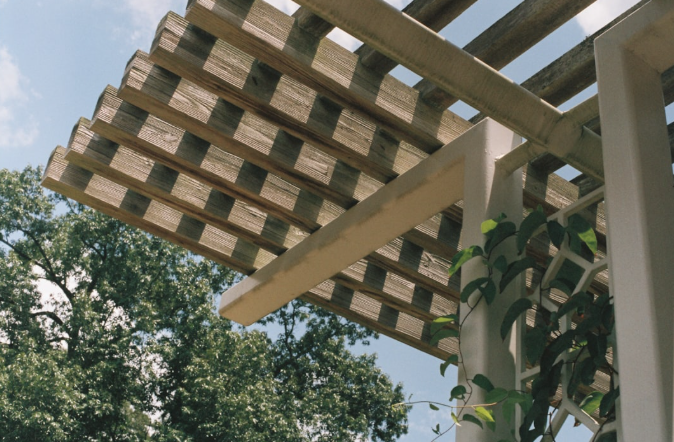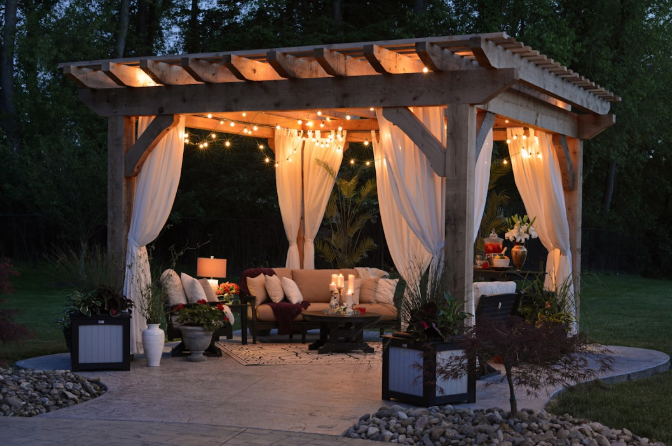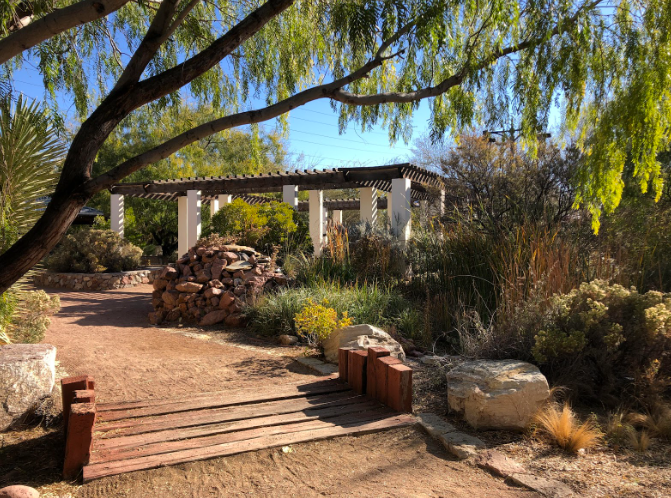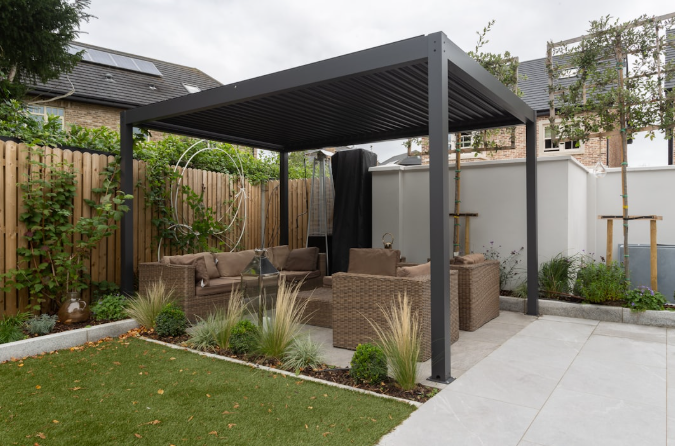When it comes to enhancing your outdoor living spaces in Texas, the choice between pergolas and arbors can significantly influence the aesthetic and functionality of your home. Both structures offer unique benefits and styles that cater to varying tastes and needs, making them popular options for homeowners aiming to create beautiful and practical outdoor areas. This guide will delve into the specifics of each design, considering the best materials suited for Texas’s climate and the practical considerations that come with installation. By consulting authoritative sources and expert advice, we aim to provide you with a comprehensive understanding of how pergolas and arbors can elevate your home improvement projects. Whether you’re seeking to add charm with arbors for homes or exploring pergola materials that withstand Texas weather, this article is crafted to help you make informed and confident decisions.
In this section, we’ll explore the key differences between pergolas and arbors, the benefits they bring to outdoor spaces, and how to select the right structure for your Texas home.
Difference Between Pergolas and Arbors
Pergolas and arbors are distinct outdoor structures that enhance your landscape in unique ways. Pergolas typically cover larger areas, providing a defined outdoor living space. They consist of vertical posts supporting a roofing grid of beams and rafters, often left open or covered with fabric or vines.
Arbors, on the other hand, are smaller and serve as decorative entryways or focal points in gardens. They usually feature two or four posts with an overhead structure, often arched, and are designed to support climbing plants.
The choice between a pergola and an arbor depends on your specific needs and the layout of your outdoor space. Pergolas are ideal for creating outdoor rooms, while arbors excel at framing pathways or garden features.
Benefits of Outdoor Structures
Adding a pergola or arbor to your Texas home can transform your outdoor living experience. These structures provide numerous benefits that enhance both the functionality and aesthetic appeal of your property.
Pergolas offer shade and shelter, creating comfortable spaces for relaxation and entertainment. They can extend your living area, providing a perfect spot for outdoor dining or lounging. Additionally, pergolas can increase property value and improve energy efficiency by reducing direct sunlight on your home.
Arbors, while smaller, add charm and character to your garden. They create inviting entryways, support climbing plants, and serve as eye-catching focal points. Arbors can also help define different areas within your landscape, guiding visitors through your outdoor space.
Both structures offer opportunities for personalization, allowing you to express your style and complement your home’s architecture.
Selecting the Right Structure
Choosing between a pergola and an arbor requires careful consideration of your outdoor space, lifestyle needs, and design preferences. Start by assessing the available area and its intended use. If you’re looking to create an outdoor living room or patio cover, a pergola might be the better choice.
Consider your home’s architectural style and how the structure will complement it. Traditional homes often pair well with classic arbor designs, while modern houses may benefit from sleek, contemporary pergolas.
Think about maintenance requirements and your willingness to care for climbing plants. Arbors are often designed to support vines, which can require regular pruning and care. Pergolas in Texas can be left bare or outfitted with retractable canopies for easier maintenance.
Design Options for Texas Homes

Explore popular styles, customization possibilities, and ways to enhance the aesthetic appeal of your outdoor space with pergolas and arbors.
Popular Styles and Trends
Texas homeowners have a wide array of pergola and arbor styles to choose from, each offering unique charm and functionality. Contemporary designs featuring clean lines and minimal ornamentation are gaining popularity, especially in urban areas.
Rustic and farmhouse-inspired structures remain a favorite in suburban and rural settings. These styles often incorporate natural wood textures and wrought iron accents, creating a warm and inviting atmosphere.
Mediterranean-inspired pergolas with arched tops and decorative columns are also trending, perfectly complementing Spanish-style homes common in parts of Texas. For a touch of elegance, Victorian-style arbors with intricate latticework continue to be a timeless choice for garden enthusiasts.
Customization Possibilities
Personalizing your pergola or arbor allows you to create a truly unique outdoor space that reflects your style and meets your specific needs. Size and shape customization is a primary consideration, ensuring the structure fits perfectly within your landscape.
Material selection offers another avenue for customization. While wood remains popular, metal and vinyl options provide durability and low maintenance. You can also mix materials, such as combining a metal frame with wood rafters for a modern rustic look.
Lighting integration is an excellent way to extend the usability of your outdoor space into the evening hours. Consider built-in LED strips, hanging lanterns, or string lights to create ambiance. Additionally, you can incorporate features like built-in seating, privacy screens, or even outdoor kitchen elements to maximize functionality.
Enhancing Aesthetic Appeal

A well-designed pergola or arbor can significantly boost your home’s curb appeal and create a stunning focal point in your landscape. To enhance the aesthetic appeal, consider the overall color scheme of your outdoor space and choose a finish that complements or contrasts effectively.
Incorporating climbing plants is a classic way to soften the structure and add natural beauty. Wisteria, jasmine, and bougainvillea thrive in Texas climates and can create a lush, romantic atmosphere. For a low-maintenance option, consider adding outdoor curtains or drapes to your pergola for a touch of luxury and privacy.
Accessorizing your structure can also elevate its visual impact. Hanging planters, decorative outdoor art pieces, or even a stylish outdoor fan can add personality and charm to your pergola or arbor, making it a true extension of your home’s interior style.
Choosing the Best Materials
Selecting the right materials for your pergola or arbor is crucial for longevity and performance in the Texas climate. Let’s explore suitable options and considerations.
Pergola Materials for Texas Weather
When selecting materials for pergolas in Texas, durability and weather resistance are key factors. Cedar is a popular choice due to its natural resistance to rot and insects. It also weathers beautifully, developing a silver-gray patina over time.
Treated pine offers affordability and good weather resistance when properly maintained. For those seeking a low-maintenance option, aluminum pergolas provide excellent durability and can be powder-coated in various colors to match your home’s exterior.
Vinyl pergolas are another low-maintenance choice, offering resistance to UV rays and moisture. They come in a variety of colors and styles, making it easy to find one that complements your home’s architecture.
Arbor Durability and Maintenance
Arbors, often smaller and more exposed to the elements, require materials that can withstand Texas weather while maintaining their aesthetic appeal. Wrought iron arbors offer classic elegance and exceptional durability, though they may require periodic repainting to prevent rust.
Composite materials, made from a blend of wood fibers and plastic, provide the look of wood with minimal maintenance. These arbors resist rot, insects, and fading, making them ideal for Texas climates.
For a natural look, redwood arbors offer excellent durability and resist decay naturally. Regular sealing can help maintain their rich color and protect against moisture damage.
Eco-Friendly and Sustainable Choices
As environmental concerns grow, many homeowners are opting for eco-friendly materials for their outdoor structures. Reclaimed wood pergolas and arbors offer a sustainable option with unique character and charm. Each piece tells a story and reduces demand for new lumber.
Bamboo, while less common, is gaining popularity as a renewable resource for outdoor structures. It grows quickly and offers strength comparable to many hardwoods. Bamboo pergolas and arbors can provide a distinctive, tropical feel to your Texas landscape.
For metal structures, look for options made from recycled aluminum or steel. These materials can be recycled again at the end of their lifespan, reducing environmental impact.
Local Installation and Services
Finding the right professionals to bring your pergola or arbor vision to life is crucial. This section will guide you through the process of selecting and working with local contractors.
Finding Reliable Contractors
Locating a trustworthy contractor for your pergola or arbor project is essential for ensuring quality workmanship and a smooth installation process. Start by researching local companies specializing in outdoor structures. Look for contractors with experience specifically in pergolas and arbors for Texas homes.
Check online reviews and ratings on platforms like Angi, HomeAdvisor, or local business directories. Pay attention to comments about reliability, communication, and the quality of finished projects. Don’t hesitate to ask for references from past clients.
Consider reaching out to local home improvement stores or lumber yards for recommendations. Many have relationships with reputable contractors and can provide valuable insights. Remember to verify that any contractor you’re considering is licensed, insured, and familiar with local building codes and permit requirements.
Cost Considerations and Quotes
Understanding the costs associated with pergola and arbor installation helps you budget effectively and avoid surprises. Factors influencing the price include the size of the structure, materials used, complexity of design, and any additional features or customizations.
When requesting quotes, be sure to get detailed, itemized estimates from at least three different contractors. This allows you to compare costs accurately and understand what’s included in each proposal. Don’t automatically choose the lowest bid; consider the contractor’s reputation and the quality of materials offered.
Be clear about your budget upfront, and discuss options for phasing the project or alternative materials if needed. Many contractors offer financing options, which can help make your project more affordable.
Importance of Professional Installation

While DIY projects can be tempting, professional installation of pergolas and arbors offers numerous benefits. Experienced contractors bring expertise in structural integrity, ensuring your outdoor addition is safe and built to last. They’re familiar with local building codes and can handle necessary permits.
Professional installation often comes with warranties on both labor and materials, providing peace of mind. Contractors have access to specialized tools and equipment, allowing for efficient and precise installation. They can also address site-specific challenges, such as uneven terrain or the need for custom footings.
Opting for professional installation can save you time and potential frustration, especially for larger or more complex projects. It ensures that your new pergola or arbor is a beautiful, lasting addition to your Texas home.
Frequently Asked Questions
Address common queries about pergolas and arbors to help homeowners make informed decisions.
Common Cost Queries
How much does a typical pergola or arbor cost in Texas?
The cost of pergolas and arbors in Texas can vary widely based on size, materials, and design complexity. On average, a basic wood pergola might start around $2,000, while more elaborate designs or those using premium materials can exceed $10,000.
Arbors generally cost less due to their smaller size, with prices starting around $500 for simple prefabricated models and ranging up to $5,000 or more for custom designs.
Factors that can influence cost include:
- Size of the structure
- Material choice (wood, vinyl, metal, etc.)
- Custom design elements
- Site preparation requirements
- Professional installation fees
Always get multiple quotes from reputable contractors to ensure you’re getting a fair price for your specific project.
Maintenance Tips and Tricks
Proper maintenance is key to extending the life and beauty of your pergola or arbor. Here are some essential tips:
For wood structures:
- Apply a protective sealant every 2-3 years
- Check for and repair any loose screws or bolts annually
- Inspect for signs of rot or insect damage regularly
For metal structures:
- Clean with mild soap and water periodically
- Touch up any scratches or chips in the finish promptly
- Apply a rust inhibitor if recommended by the manufacturer
For vinyl structures:
- Wash with soap and water as needed
- Avoid using abrasive cleaners that could damage the surface
- Check for any cracks or damage annually
Regular pruning of climbing plants helps maintain the structure’s integrity and appearance. Remove debris from the top of the structure after storms to prevent moisture buildup.
Customization Options Explained
Customizing your pergola or arbor allows you to create a unique outdoor space that perfectly suits your needs and style. Popular customization options include:
- Size and shape adjustments to fit your specific space
- Material choices, including wood types, metal finishes, or composite options
- Roofing additions, such as retractable canopies or polycarbonate panels
- Built-in features like benches, planters, or outdoor kitchen elements
- Lighting integration, from simple string lights to sophisticated LED systems
Color customization is another way to personalize your structure. Many homeowners choose to match their pergola or arbor to their home’s trim or select a complementary accent color.
For arbors, consider adding decorative elements like scrollwork, lattice panels, or even a small gate. These touches can transform a simple arbor into a charming garden focal point.
Remember that while customization can enhance your outdoor space, it may also impact the overall cost and installation time of your project. Discuss your ideas with your chosen contractor to understand feasibility and budget implications.

